We may not have the course you’re looking for. If you enquire or give us a call on +1 7204454674 and speak to our training experts, we may still be able to help with your training requirements.
Training Outcomes Within Your Budget!
We ensure quality, budget-alignment, and timely delivery by our expert instructors.

Businesses frequently need to evolve to stay relevant in the ever-changing consumer market. These changes could be related to the technology used, business practices, organisational goals, employees, etc. To manage these changes effectively, businesses need to use Change Management. Understanding "What is Change Management?" can help you navigate these transitions successfully. Further, there are multiple aspects of Change Management that can prove helpful to businesses. Want to know how? Read this blog to learn about its different types, benefits, and more.
Table of Contents
1) What is Change Management?
2) Change Management process
3) Types of Change Management
4) Change Management strategy
5) Change Management tools
6) Advantages and disadvantages of Change Management
7) Tips for effective Change Management
8) Conclusion
What is Change Management?
Change Management is the set of procedures an organisation should follow, changes can be implemented without any trouble, and they can be assessed seamlessly. It assists businesses in adapting to or enhancing their performance under the new conditions. The change could be technology, processes, structure, culture, or strategy. Managing change is the primary focus of minimising disruption and resistance from the change while enhancing benefits and outcomes.

Change Management principles
There are mainly three principles of Change Management which are primarily based upon the three stages of Change Management. This is introduced in the book “Principles of Topological Philosophy’ by Kurt Lewin. Let’s explore these three principles below:
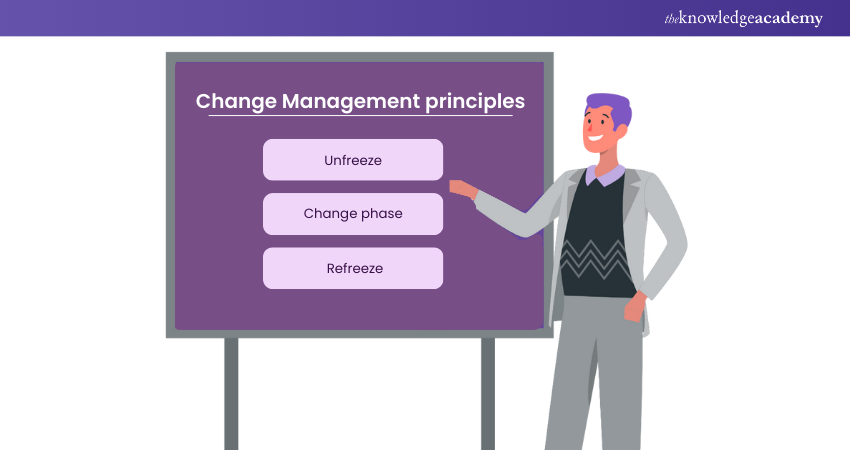
a) Unfreeze: This is the stage where Change Managers decide about the changes that need to be made. They need to clearly understand why such a change is essential. They also gather people who fit well to implement the change in the organisation. It is similar to ice melting where the entire management structure is dissolved so it can take a new shape again.
b) Change phase: In this phase, the Change Managers or Change Agents start to implement the changes. The management communicates with each other to convey the idea and make an effective change. They carefully find loopholes and make necessary arrangements to fix and move on. This new change can bring some comfort to employees, and it is important to acknowledge that.
c) Refreeze: Once people get used to the changes in the organisation, they all start working like before. In this refreeze stage, the company declares that the change is over irrespective of its acceptance or rejection. This declaration helps everyone to relax and keep a note of the change for future reference.
Change Management models
Change Management Models are frameworks which help organisations to plan, evaluate and implement change. There are four primary models which are popularly used by organisations. Let’s discuss these models:
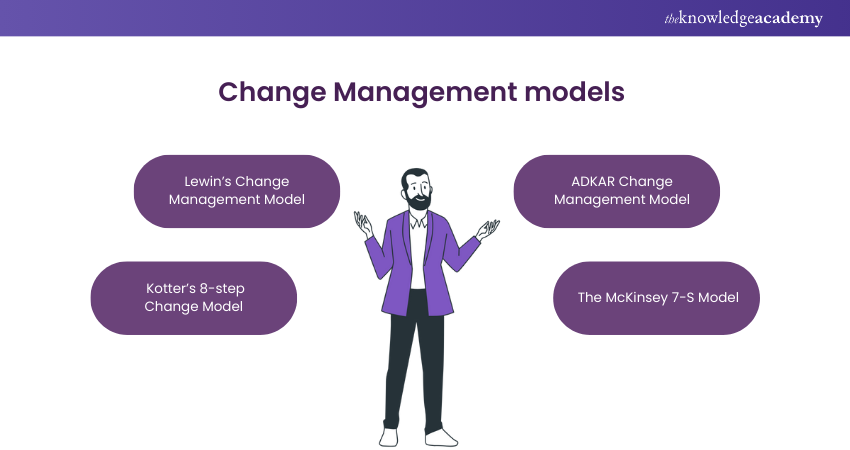
a) Lewin’s Change Management Model: This theory, proposed by Kurt Lewin, assumes that the Change process is composed of three phases of unfreezing, changing, and refreezing. This stage involves the readiness of the organisation to change by motivating its members to believe in the necessity and showing them that it is worth the risk. Changing includes preparation for the change that involves providing support systems and guidance.
b) Kotter’s 8-step Change Model: This model of change, which was worked out by John Kotter, provides steps of eight stages which are; create awareness, make a group of supporters, develop a vision, implement a vision and communicate, make people understand the change, achieve quick wins, solidify the changes and finally anchor the change. All modules aim to ensure that you avoid common problems and difficulties conditioning.
c) ADKAR Change Management Model: In Prosci’s adaptation of the Change Management model change occurs at the individual scale. The framework of the ADKAR theory is built on the principles of Awareness, Desire, Knowledge, Ability, and Reinforcement. These are the mains highlights that help a person to achieve success. The model assists managers and Change Agents in ensuring implementation is harmonious.
d) The McKinsey 7-S Model: This McKinsey & Company model identifies the seven factors such as strategy, structure, systems, values, skills, style, and staff. The approach aims to help managers and change agents to harmonise these aspects in making sure that the transformation is effective and maintains sustainability.
Do you want to learn Change Management Strategies to engage stakeholders effectively? Register now for our Managing Organisational Change Effectively Course!
Change Management process
The Change Management Process moves from the existing status of the project to the future perspective wished for by an individual, group or organisation through the intervention of a person or an organisation. The process is done by determining the requirements for change which in turn will be put in the plan and this involves stating the objective, the scope, the impact, etc.
Considering the nature of vesting and communication, these two key factors are vital for supporters’ getting involved and addressing any concerns. The steps, resources, and timelines are considered during planning and implementation whereas they ensure that the transition is smooth and efficient. The trainees will be offered support to help them cope with transition.
Data should be monitored throughout the process, so that it can be refined accordingly to make it relevant.
Join our comprehensive Change Management Foundation and Practitioner Course today and unlock the tools to drive transformation with confidence. Don't miss out – register now!
Types of Change Management
There are three types of Change Management which are followed by individuals, organisations, and other enterprises. Let’s have a look at these three types:
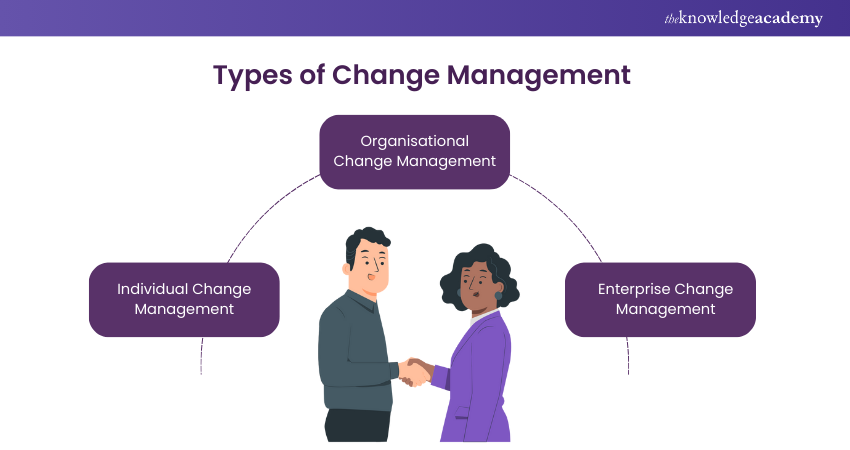
Individual Change Management
Individual Change Management includes the practices followed to help individuals accept newly introduced changes in the organisation. For instance, sometimes, when new changes are brought in, certain employees' responsibilities increase. Individual Change Management involves practices that help them handle their new duties and contribute more to the organisation. There are different types of Individual Change Management:
a) Incremental Change Management: It is a change that is applied gradually. Minor, almost unnoticeable changes manifest themselves slowly in the organisation.
b) Pendulum Change Management: This type of change hits individuals without warning in an organisation. For instance, introducing a new process, which has no connection with the previously used process, can constitute a pendulum change.
c) Paradigm Change Management: A paradigm change refers to the entire value system of an individual undergoing modifications. When individuals improve their values, their approach to work and the methods used also change. This implies that their future actions will complement the organisational goals well.
Register in our specialized Change Management Assessments Training. Gain the expertise to evaluate, strategize, and implement effective change initiatives. Elevate your capabilities – sign up now!
Organisational Change Management
Processes to implement large-scale changes brought to an organisation are known as Organisational Change Management. This includes changes brought to the organisation structure or upgrading technology. The various types of Change Management in organisations are as follows:
a) Evolutionary Change Management: This is centered around the idea of natural selection, i.e., small changes are introduced in the types of processes used for developing products or services.
b) Revolutionary Change Management: This type primarily refers to changes that had to be forcefully included in organisations due to external factors. This could occur due to a recent change in power.
c) Directed Change Management: This has been designed with specific objectives in mind. All aspects of the organisation, like management style, employees, work culture etc., stand the chance of getting affected.
Enterprise Change Management
Enterprise Change Management deals with changes in all aspects of the business, from management roles to procedures. Changes made in a single department can be felt across other departments as well. Thus, it is essential to ensure that all aspects of the business will receive changes in the same way and that one department’s improvement will not affect the other negatively.
Do you want to improve your job prospects in Change Management? Then register now for our Certified Professional Change Management (CPCM) Course!
Change Management strategy
A Change Management strategy is counted as a successful approach to transforming individuals, teams, and organisations from a status quo to the targeted future state. The entire process begins with formulating the Change Management plan, laying out its objectives and communicating this effectively to the various stakeholders, and gaining their approval.
The strategy denotes organising for change through training and support, the implementation for change in steps, monitoring the changes, and facing resistance through feedback and adaptive mechanisms. The main thing is the constant control of the result of changes and its relevance to organizational goals. Proper Change Management brings flexibility, decreases interference, and provides all-round enhanced organisation performance and reliability.
Do you want to learn some essential principles of the Change Management process? Sign up now for our Change Management Foundation Course!
Change Management tools
Change Management tools help companies and managers to research, organise, study and implement changes. Gantt charts, flowcharts, and spreadsheets are some of the tools used in smaller companies. This provides an overall integrated view of changes and their effects. Some of the other popular Change Management Tools include the following:
a) ChangeGear: It is used for DevOps and ITL automation.
b) ChangeScout: It is a cloud-based application used for analysing incremental changes.
c) eChangeManager: It is a standalone, cloud-based Change Management application.
d) Freshservice: Freshservice is an online solution that features workflow customisation capabilities and other features.
e) Remedy Change Management: It helps managers in planning, tracking and implementing successful changes in the organisation.
Learn how you can become a successful Change Management Practitioner with our Change Management Practitioner Course!
Advantages and disadvantages of Change Management
The importance of Change Management can be understood from the many scenarios that it brings to an organisation. Whether it be a change in the business process or a change in leadership, every change that occurred had a significant impact on the organisation. There are several advantages and disadvantages of Change Management, which we will discuss here:
Advantages of Change Management
Let’s look at some advantages of Change Management:
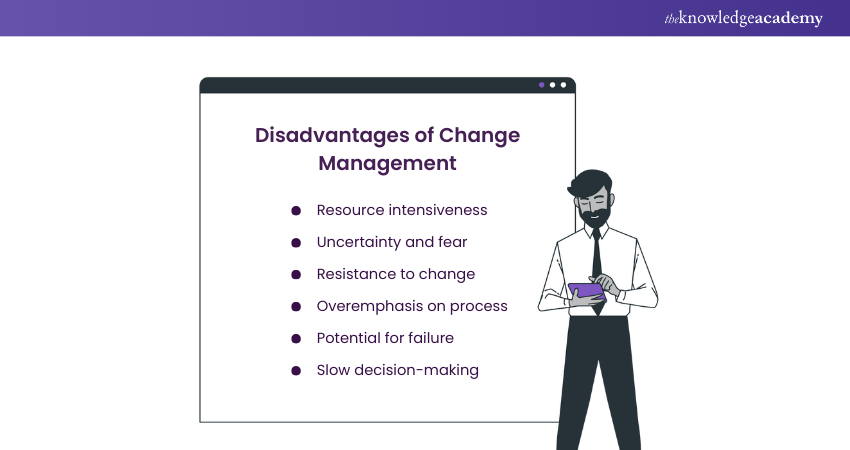
a) Improved adaptability: The business ability to quickly adapt to market variation and internal problems increases. This ability of businesses improves competitiveness.
b) Minimised resistance: Leading role of proper Change Management approaches lie in the fact that they contribute to the reduction of employee resistance through communication, explanation, and involvement, which leads to the filing of smoother processes.
c) Increased efficiency: This means that through introducing change initiatives, organisations will be able to develop processes that are systematical, eliminating redundancies and should be more efficient.
d) Better Risk Management: From the very start of Change Management proactive stance allows to distinguish and avoid possible threats to change process transition.
e) Enhanced innovation: By becoming an active participant in change the organisation continues to develop a culture of innovation, with new ideas being recognised and things are constantly increasing.
f) Stakeholder engagement: Change Management that involves participants at all levels and gives personnel a chance to present their concerns is likely to be perceived positively.
g) Clear vision and direction: The appropriate Change Management creates a vision of where the business is going supported by the strategy, which explains further what is needed to reach the goals and in what developmental way employees should do it.
Ready to achieve mastery in Change Management? Level up with our Change Management Black Belt course.
Disadvantages of Change Management
There are cons of Change Management as well. It is better that you know both the pros and cons before implementing Change Management process in your organisation:
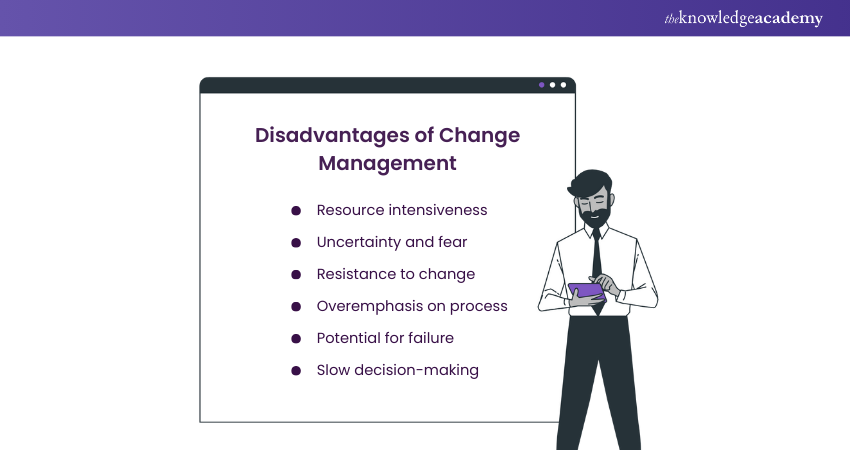
a) Resource intensiveness: The creation and implementation of the program is costly in terms of time, effort and financial resources, especially for the smaller organisations.
b) Uncertainty and fear: Faced with change, an employee's confidence can fall, creating stress, a decrease in motivation and low productivity, if not managed appropriately.
c) Resistance to change: Employees resist sometimes if all the changes in the organisation are applied at once. Moreover, deploying them all at once becomes a stumbling block for progress and may lead to conflicts also.
d) Overemphasis on process: Sometime the focus on the Change Management process distracts from what really matters, the change goals and needs, making the change not as effective as before.
e) Potential for failure: Not all Change Management initiatives are successful; they may also fail if proper planning is not done, communication channels are not open, or the stakeholders are not involved.
f) Slow decision-making: The comprehensive Change Management procedures occasionally hamper decision-making, and implementation of the essential changes gets postponed.
g) Risk of misalignment: It will also remain unknown whether the Change Management strategy will correlate with the other strategies or goals of the organization, thus creating ambiguities.
Learn how you can manage change with Agile Methodology – register now with our Managing Change with Agile Methodology Training!
Tips for effective Change Management
The strategies adopted to implement Change Management differ among organisations. But some standard processes help in simplifying the process. Here are some helpful tips for witnessing effective Change Management:
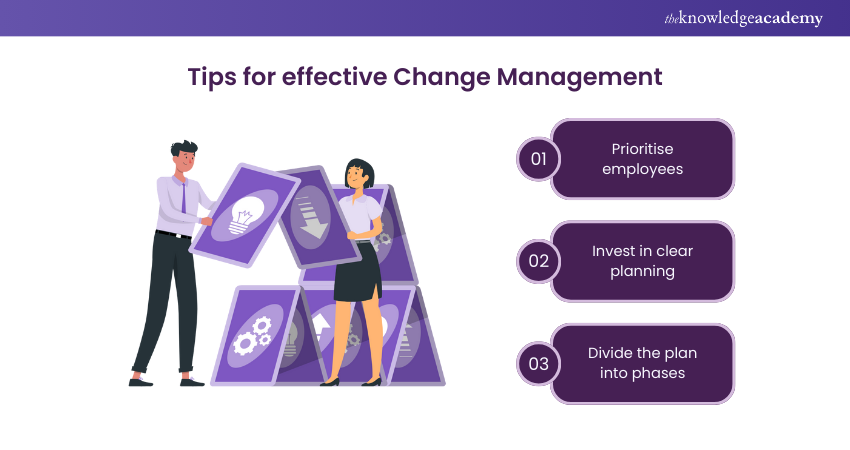
a) Prioritise employees: One of the significant challenges faced while introducing changes in organisations is facing resistance from workers. Listening to your employees and addressing the resistance is imperative instead of forcing change upon them. Communicate the relevance of the changes to them and guide them through embracing the change instead of fighting it.
b) Invest in clear planning: A detailed plan to manage change is vital to successful change implementation. Clear planning helps you foresee and eliminate risks, resulting in smooth Change Management.
c) Divide the plan into phases: It can sometimes be overwhelming for employees to accept large-scale organisational changes. In such cases, it is preferred to break the plan into smaller phases and implement the required changes slowly. This gives enough time for employees to get used to the changes and ensure that it gets embedded properly into the functioning of the organisation.
Ready to take your Change Management skills to the next level? Register in our Change Management Green Belt course.
Conclusion
We hope that from this blog you are got to know What is Change Management and its key principles. Change Management processes are beneficial for implementing changes successfully in organisations. Even though it is a difficult phase for the organisation and its employees, if the change serves its purpose, it can be fruitful.
Learn about the various principals and aims of Risk Management with our Risk Management for Change Training.
Frequently Asked Questions

Change Management is about designing a systematic change mechanism to reduce resistance and strengthen engagement. It comprises recognising the need for change, engaging with key players, empowering workers through training and support, and guiding them through the transition.

Here are five key elements of Change Mangement:
a) Vision and strategy
b) Leadership
c) Communication
d) Training and support
e) Monitoring and evaluation

The Knowledge Academy takes global learning to new heights, offering over 30,000 online courses across 490+ locations in 220 countries. This expansive reach ensures accessibility and convenience for learners worldwide.
Alongside our diverse Online Course Catalogue, encompassing 17 major categories, we go the extra mile by providing a plethora of free educational Online Resources like News updates, Blogs, videos, webinars, and interview questions. Tailoring learning experiences further, professionals can maximise value with customisable Course Bundles of TKA.

The Knowledge Academy’s Knowledge Pass, a prepaid voucher, adds another layer of flexibility, allowing course bookings over a 12-month period. Join us on a journey where education knows no bounds.

The Knowledge Academy offers various Change Management Certifications, including Change Management Foundation and Practitioner Courses. These courses cater to different skill levels, providing comprehensive insights into Change Management Plans.
Our Project Management Blogs cover a range of topics related to Change Management Certification, offering valuable resources, best practices, and industry insights. Whether you are a beginner or looking to advance your Change Management skills, The Knowledge Academy's diverse courses and informative blogs have you covered.
Upcoming Project Management Resources Batches & Dates
Date
 Change Management Foundation & Practitioner
Change Management Foundation & Practitioner
Mon 13th May 2024
Mon 22nd Jul 2024
Mon 23rd Sep 2024
Mon 4th Nov 2024







 Top Rated Course
Top Rated Course


 If you wish to make any changes to your course, please
If you wish to make any changes to your course, please


